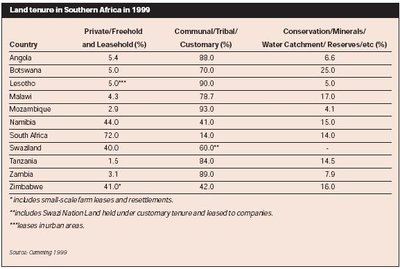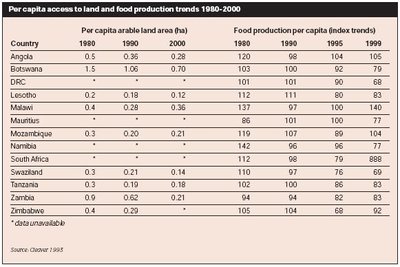Southern Africa and land resources
Contents
- 1 Introduction Cattle grazing in Miombo, north-western Zimbabwe. (Source: Y. Katerere) Southern Africa covers a total land area of 693,000 million hectares (ha), of which approximately 20 percent is arable as shown in the table below. Arable and domesticated land is used for agriculture (Southern Africa and land resources) , forestry, wetlands and wildlife conservation, and human settlements.
- 2 Endowments and opportunities
- 3 Challenges faced in realizing opportunities for development
- 4 Further reading
Introduction Cattle grazing in Miombo, north-western Zimbabwe. (Source: Y. Katerere) Southern Africa covers a total land area of 693,000 million hectares (ha), of which approximately 20 percent is arable as shown in the table below. Arable and domesticated land is used for agriculture (Southern Africa and land resources) , forestry, wetlands and wildlife conservation, and human settlements.
Endowments and opportunities
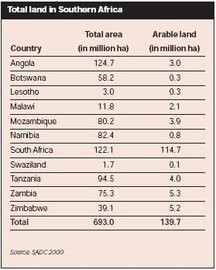 Total land in Southern Africa (Source: SADC 2000)
Total land in Southern Africa (Source: SADC 2000) Economic growth in the sub-region is closely linked to land resources. The strongest growth was in Angola which grew at 11.5 percent in 2004 (linked to oil and diamonds) and 8.3 percent in Mozambique (strong agricultural performance and donor support). South Africa, which accounts for one-fifth of Africa’s total GDP, grew at 2.8 percent in 2004. Increased mining activities was the key growth factor in Botswana, Mozambique, Namibia and Zambia; agricultural expansion was an important factor in Mozambique and Zambia, and increased tourist activity in South Africa and Zambia.
Crop production is the dominant land use, contributing about 34 percent to GDP. For this reason, the performance of crop production has a strong influence on food security, economic growth and stability. As most economies in Southern Africa are based on agriculture, there is a big demand for arable land, mainly in the rural areas. Up to 62 percent of the population lives in rural areas, depending on agriculture for their livelihood. There is a growing trend towards export agriculture, influencing an increase in the production of cash crops including cotton, tobacco, tea, coffee, sugar and wheat. However, maize, a staple food for the majority of the region’s population, is still an important crop and is widely grown. Increased commercial agriculture offers important employment opportunities. However, where labour is gendered, as it is in much of Africa, with cash crops identified as men’s crops and subsistence food crops as women’s crops, women may not derive the same benefit. Disproportional income levels are also a factor in the gendered nature of poverty.
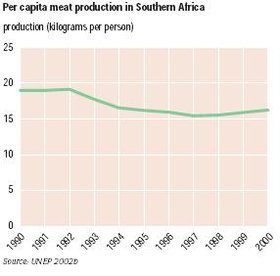 Per capita meat production in Southern Africa (Source:UNEP 2002)
Per capita meat production in Southern Africa (Source:UNEP 2002) Livestock farming is another common form of land use, although livestock production has fluctuated over the last three decades due to drought and diseases such as foot-and-mouth, cattle-lung disease and anthrax. Meat production per capita has generally been declining as shown in the figure to the left.
Challenges faced in realizing opportunities for development
Land tenure arrangements and associated equity issues are a major threat to the sustainable use of land resources. The communal land tenure system is the most widespread, in which individual property rights are weak. In some countries, particularly Namibia, South Africa and Zimbabwe, colonial dispossession and weak land tenure rights are key factors in the high levels of unemployment and poverty. Unemployment rates are particularly high in Namibia (34 percent) and South Africa (30 percent). The land tenure system is closely associated with social inequity, including high levels of income inequality. The Gini index, which is a measure of the extent of inequality in a country, is 50 in Zimbabwe, 59 in South Africa and 74 in Namibia, while the SSA average is 42.8 and the global average is 40.0.
The table shows the land tenure system in 1999. The situation has changed quite a lot, especially in Zimbabwe, where the government has made efforts to decongest rural areas, settle landless people and deracialize commercial agriculture by acquiring 10 million ha of prime large-scale farms for resettlement.
The major cause of tenure insecurity in the communal lands is the lack of devolution of planning and decision making, poor resource-mobilization, inadequate enforcement and inadequate administration of matters relating to the affairs of local communities.
Trade liberalization and globalization are putting severe pressure on the livelihoods of the people, resulting in many having to depend further on land and other natural resources. Notable among these factors are a fall in formal sector employment, privatization of key resources and enterprises, reduced levels of state support to agriculture, and the continuing marginalization of the non-commercial or peasant sectors.
Declining per capita landholdings and the general skewed land ownership pattern in Southern Africa have been accompanied by a fall in human well-being indicators, such as per capita food production. The production of cereals, root crops and livestock, which form the primary staple food in Southern Africa, has been increasing since 1970, but has not kept pace with population growth, resulting in overall per capita food production falling by 25 per cent since 1980. While the declining trends in per capita food production are largely attributable to declining landholding sizes as shown in Table 10, other factors have also shaped the trends over the past two decades. Drought is one factor that caused a significant decline in the per capita food production index for Southern Africa following the poor seasons experienced in 1991-92, 1994-95, 2001-03 and 2004-05.]
Soil erosion is the most widespread form of land degradation, and one of the biggest threats to agricultural productivity in Southern Africa. It is estimated that about 15 percent of the land is degraded through erosion.Land policy debates are characterized by a range of challenges:
- The privatization of resources, including both communal and state resources;
- The retreat by the state from key areas of the economy, including both productive activities and services;
- The pursuit of FDI;
- The sweeping deregulation of markets;
- Dealing with the emerging issue of genetically modified organisms (GMOs); and
- Effectively reforming the land sector.
As a result there is convergence of policy in key areas that can be attributed to the growing exposure of the sub-region to globalization, which has seen an accelerated phase of regional integration and intergovernmental programmes such as the Regional Indicative Strategic Development Plan (RISDP).
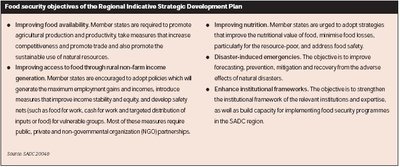 Food Security of the RISDP
Food Security of the RISDP(Source: SADC 2004)
The Southern African Development Community member states have demonstrated strong commitment to implement the UNCCD by ratifying it and by developing national and sub-regional programmes to combat desertification. The SADC Sub-Regional Action Programme (SRAP), which was approved by the SADC Council of Ministers in 1997, provides a collective response to problems of land degradation, drought and desertification, especially those of a transboundary nature.
Further reading
- Chenje, M. (ed., 2000). State of the Environment—Zambezi Basin 2000. Southern African Development Community, IUCN – The World Conservation Union, Zambezi River Authority, Southern African Research and Documentation Centre, Maseru/Harare/Lusaka.
- Cleaver, K.M., 1993. A Strategy to Develop Agriculture in Sub-Saharan Africa and a Focus for the World Bank.Technical Paper No. 203. World Bank,Washington, D.C.,
- ECA, 2005. Economic Report on Africa 2005: Meeting the Challenges of Unemployment and Poverty in Africa. Economic Commission for Africa, Addis Ababa.
- Katerere,Y. and Guveya, E., 1998. Seeking New Perspectives in Land and Natural Resources Management. In Setting the Foundation for Building Capacities, Networking and Research on Land Reforms in Southern Africa. (eds. Marongwe, N. and Matowanyika, J.J.Z.) Proceedings of a regional workshop, Maseru, Lesotho, 1-3 July.
- SLSA, 2001. The Politics of Land Reform in Southern Africa. Sustainable Livelihoods in Southern Africa. SLSA Land Theme Research Briefing 1 November. Sustainable Livelihoods in Southern Africa, Cape Town.
- Southern African Development Community (SADC)
- UNEP, 2002a. Africa Environment Outlook: Past, Present and Future Perspectives. United Nations Environment Programme, Nairobi.
- UNEP, 2006. Africa Environment Outlook 2
|
|
| Disclaimer: This article is taken wholly from, or contains information that was originally published by, the United Nations Environment Programme. Topic editors and authors for the Encyclopedia of Earth may have edited its content or added new information. The use of information from the United Nations Environment Programme should not be construed as support for or endorsement by that organization for any new information added by EoE personnel, or for any editing of the original content. |
